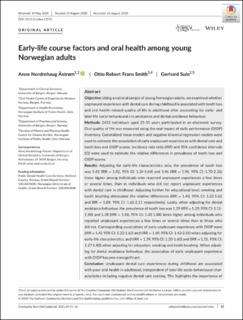| dc.description.abstract | Objective
Using a national sample of young Norwegian adults, we examined whether unpleasant experience with dental care during childhood is associated with tooth loss and oral health–related quality of life in adulthood after accounting for early- and later-life socio-behavioural circumstances and dental avoidance behaviour.
Methods
2433 individuals aged 25-35 years participated in an electronic survey. Oral quality of life was measured using the oral impact of daily performance (OIDP) inventory. Generalized linear models and negative binomial regression models were used to estimate the association of early unpleasant experiences with dental care and tooth loss and OIDP scores. Incidence rate ratio (IRR) and 95% confidence intervals (CI) were used to estimate the relative differences in prevalence of tooth loss and OIDP scores.
Results
Adjusting for early-life characteristics only, the prevalence of tooth loss was 1.42 (IRR = 1.42, 95% CI: 1.24-1.64) and 1.96 (IRR = 1.96, 95% CI: 1.70-2.26) times higher among individuals who reported unpleasant experiences a few times or several times, than in individuals who did not report unpleasant experiences with dental care in childhood. Adjusting further for educational level, smoking and tooth brushing attenuated the relative differences (IRR = 1.40, 95% CI: 1.22-1.62 and IRR = 1.88, 95% CI: 1.62-2.17, respectively). Lastly, when adjusting for dental avoidance behaviour, the prevalence of tooth loss was 1.29 (IRR = 1.29, 95% CI: 1.11-1.50) and 1.58 (IRR = 1.58, 95% CI: 1.32-1.88) times higher among individuals who reported unpleasant experiences a few times or several times than in those who did not. Corresponding associations of early unpleasant experience with OIDP were (IRR = 1.41 95% CI: 1.22-1.63) and (IRR = 1.69, 95% CI: 1.42-2.01) when adjusting for early-life characteristics, and (IRR = 1.39, 95% CI: 1.20-1.60) and (IRR = 1.51, 95% CI: 1.27-1.80) when adjusting for education, smoking and tooth brushing. When adjusting for dental avoidance behaviour, the association of early unpleasant experience with OIDP became nonsignificant.
Conclusion
Unpleasant dental care experiences during childhood are associated with poor oral health in adulthood, independent of later-life socio-behavioural characteristics including negative dental care seeking. This highlights the importance of tailoring regular contacts with dental healthcare services in childhood to build confidence in children and thus has implications for healthcare policy. | en_US |

